25 Remarkable Facts About The Galapagos Islands
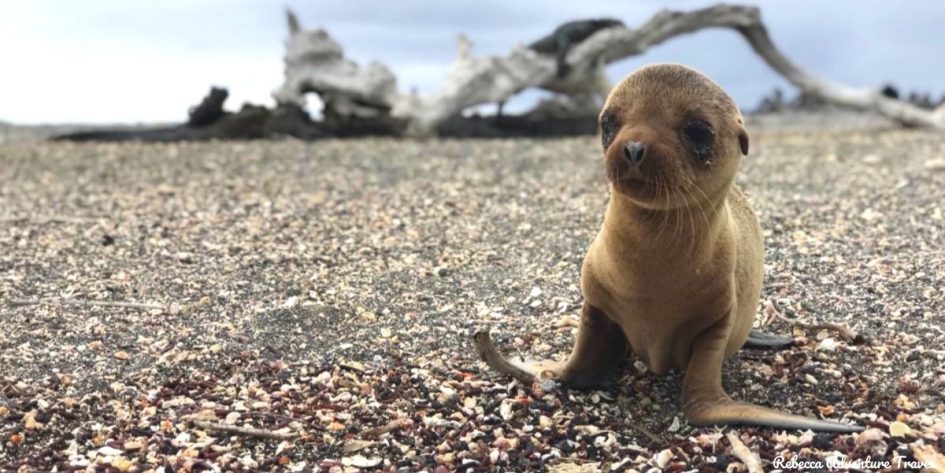
How many Galapagos Islands fun facts are you familiar with? You probably know that naturalist Charles Darwin based his theory of biological evolution on his travels to the islands. However, did you know that he only stayed five weeks on the islands?
Also, you might have heard that the Archipelago is a biodiversity hotspot. Yet, one of the cool facts about the Galapagos Islands is that 20% of the marine species are endemic. This means that they can only be found in the Enchanted Islands! If you want to impress your family and friends with fun information for your next vacation, in this blog you’ll find 25 Remarkable Facts About the Galapagos Islands.
Interesting facts about the Galapagos Islands
The Galapagos Islands have been a favorite travel destination for many decades. Likewise, tourists love its pearl beaches, turquoise oceans, amber rocks, and diamond skies. Also, they marvel at its wondrous wildlife.
The islands have one of the highest levels of endemism in the world. For instance, a variety of animals swim freely in the Marine Reserve. If you’re lucky, you might be able to see different types of sharks, whales, and dolphins. In addition, there are also seals, penguins, sea lions, boobies, and giant turtles, among many more.
Further, traveling to the Galapagos Islands is a chance to reconnect with nature in a special way. Likewise, you can escape from the noise and the crowds. It’s a peaceful and meaningful experience for the whole family. Even so, the Galapagos is one of the safest places to travel. In the islands, you’ll find strict safety protocols to protect its people and ecosystems.
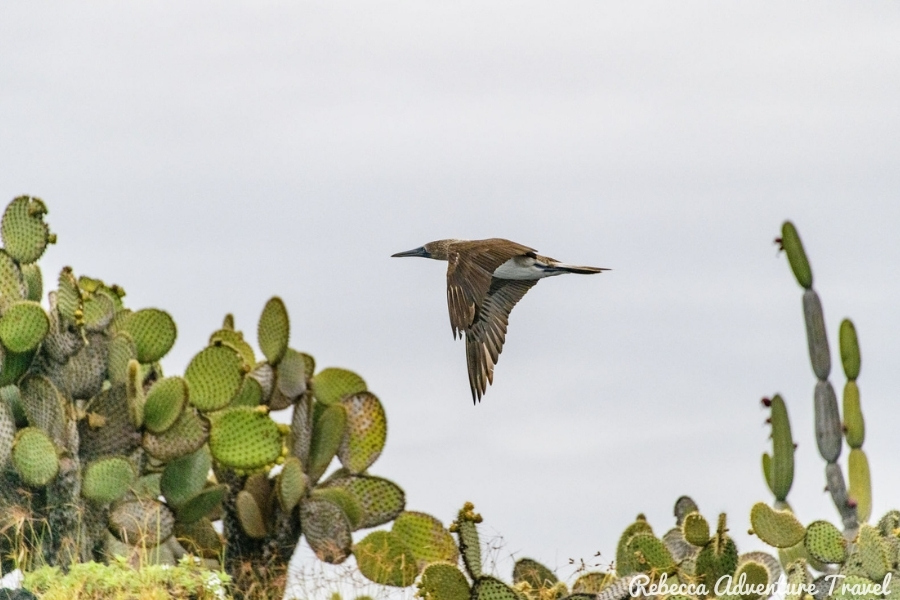
Blue-footed booby on the air.
There are endless reasons to fall in love with the majestic Enchanted islands. Why are the Galapagos Islands so special? Because it’s the most beautiful place on Earth! In this blog, you’ll find 25 fun facts about the Galapagos Islands.
1. Galapagos is one of the most safeguarded places on Earth
Are the Galapagos Islands protected? Yes! The archipelago is a national park. Moreover, its extraordinary flora and fauna make the park a center for scientific research and tourism. The Galapagos National Park (GNP) covers 97% of the land of the pristine paradise that is the archipelago. It was established in 1959, becoming the oldest park in Ecuador. A Galapagos Islands fact is that the other 3% are inhabited areas of Santa Cruz, San Cristóbal, Isabela, Balta, and Floreana Islands.
Moreover, the Galapagos Marine Reserve is one of the largest and most biologically diverse marine areas in the world. It covers 198,000km² (76,448mi²) of the ocean. The Galapagos Park Administration monitors more than 3,000 marine species.
The Galapagos Marine Reserve has been protected since 1998. Also, on January 14, 2022, the Ecuadorian government expanded its coverage to curb overfishing. Thus, by a decree, Ecuador President Guillermo Lasso limited commercial fishing activity.
The new boundary links the marine reserves of Colombia, Costa Rica, Ecuador, and Panama. It forms the Eastern Tropical Pacific Marine Corridor. This new declaration protects vulnerable and threatened migratory species. The archipelago is home to many endemic species, such as:
- Mammals: Whales, dolphins, Fur seals, and Sea Lions.
- Birds: Albatrosses, Penguins, Cormorants.
- Fish: Sharks, Rays, and tropical fishes.
- Lizards: Marine Iguanas.
- Reptiles: Sea turtles.
Galapagos has different habitats that need conservation
The Galapagos National Park preserves very diverse habitats. For instance, underwater there are volcanoes and mountains known as seamounts. They rise to the water’s surface. A Galapagos Islands fact is that seamounts are feeding grounds for fish as well as birds, sea lions, and turtles. On the ocean, there are also reefs, cliffs, wetlands, and lagoons.
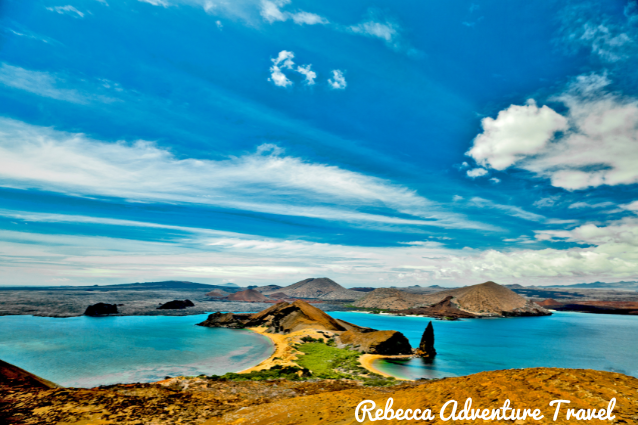
Galapagos Islands have vulnerable ecosystems that need to be protected.
Because of its vulnerable ecosystems, Galapagos Islands need to be overly protected. It’s essential to conserve its species and restore its habitats. That’s why not every part of the park is open to the public. However, with an official park-certified guide you can visit safe and protected areas.
The Galapagos Islands fact is that it’s a UNESCO World Heritage site
In 1978, Galapagos was designated a UNESCO Natural World Heritage site. The islands were recognized because of their unusual plant and animal life. Several years later, in 1984, it was declared a UNESCO Biosphere Reserve. In 2002, Isabela’s Wetlands were declared a Ramsar Site.
Did you know that Galapagos was the first place to be recognized by UNESCO, and Quito was second? Ecuador has five properties inscribed on the World Heritage List (three cultural and two natural). They are:
- Galapagos Islands (1978, 2001)
- City of Quito (1978)
- Sangay National Park (1983)
- City of Cuenca (1999)
- Qhapaq Ñan, Andean Road System (2014)
2. How were the Galapagos Islands formed?
Galapagos is a very active archipelago because of its youth. It’s thought to have been formed about 3-4 million years ago. Isolated in the Pacific Ocean, the islands were formed by the interaction of tectonic plates and hot spot volcanism. A Galapagos Islands fact is that its creation is a unique process on Earth. Until now, scientists still try to figure out exactly how they were formed.
According to scientist Kenneth Leonard, the Galapagos “consists of thirteen major islands and hundreds of smaller rocky outcroppings.” He explains that one volcano formed the islands, except for Isabela Island. Isabela was formed from the union of six different volcanoes. The repeated volcanic eruptions helped form the mountainous landscape of the archipelago.
Galapagos is a volcanic hotspot
The islands were created by underwater volcanic eruptions. The volcanic origin of the Galapagos Hotspot sits 3,000 ft. (914,4 m) under the ocean and is located on Fernandina Island.
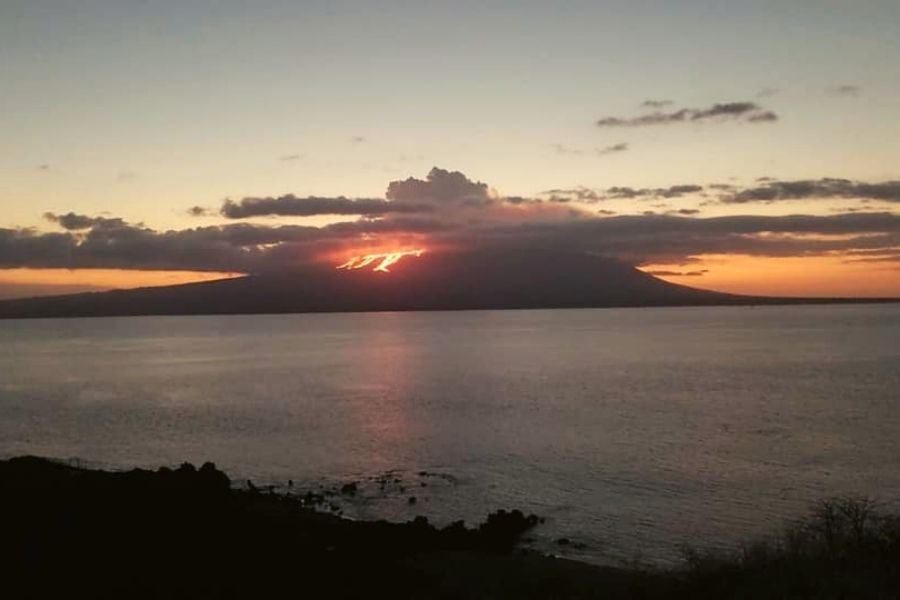
La Cumbre Volcano erupted in 2020. Credit: Diario EL UNIVERSO, 2020.
The islands sit on the Nazca Plate, located in the middle of the Pacific Ocean. A Galapagos Islands fact is that this plate moves slowly at 5 cm (0,16 ft) per year, creating volcanic activity. That’s why in the last 200 years, more than 50 eruptions have occurred.
The islands are formed by the juncture of three tectonic plates. Its location makes the area volcanically active. The plates are:
- Pacific
- Cocos
- Nazca
Volcanic activity in the Galapagos
The archipelago was formed from lava oozing from the volcanic action on the Nazca Plate. A Galapagos Islands fact is that it’s one of the most volcanically active areas in the world. Therefore, in geological terms, the islands are considered very young. Nowadays, there are 13 active volcanoes with intermittent activity out of 21 volcanoes in total. The most recent eruptions were:
- Wolf (2022)
- La Cumbre (2020)
- Sierra Negra (2018)
- Wolf (2015)
- Ailedo (1993)
On January 7th, 2022, the Wolf Volcano erupted on Isabela Island. It spewed lava and ash over the Pacific Ocean. The Wolf Volcano, which rises to 3,793 m (12,444 ft) above sea level, is the tallest mountain in the Galapagos.
3. Galapagos is formed by 127 islands, islets, and rocks
How many islands are in the Galapagos? The archipelago consists of 127 islands, islets, and rocks. Of the total, 19 are large islands and four are inhabited. Galapagos is small but unique. It’s made up of 7,880 km² (3,040 mi²) of land and 45,000 km² (17,000 mi²) of the ocean.
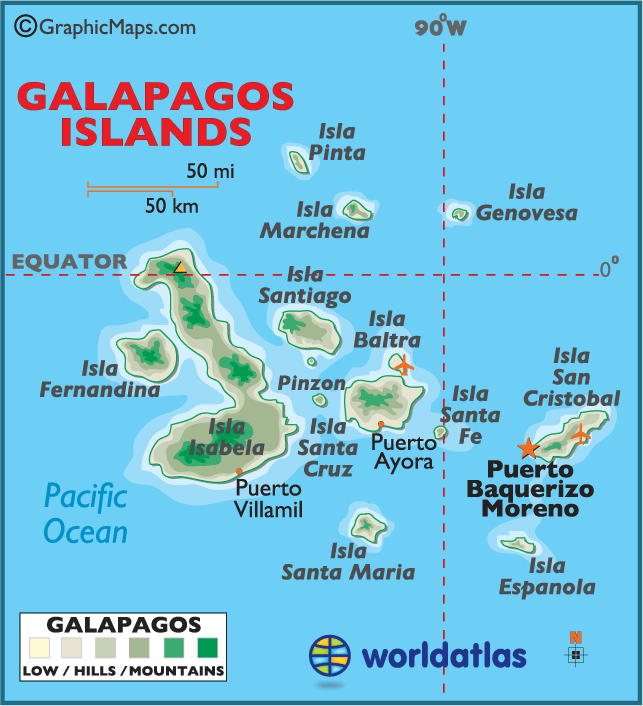
Galapagos has 127 islands, islets, and rocks. Credit: Worldatlas.com
Isabela is the largest island in the archipelago
The islands were formed of lava piles. Its arid landscape has high volcanic mountains, craters, and cliffs. Isabela is the largest island, approximately 132 km² (82 mi²) long. Even so, Isabela makes up nearly ¾ of the entire land surface of the Galapagos. Tourists can find Mount Azul at 1,689 m (5,542 ft) which is the highest point of the Galapagos. Santa Cruz is the second largest island.
Spread over 45,000km² (17,000mi²) of the ocean, the land surface of the islands is 7,880km² (3,040mi²). Española Island is the furthest south, while Darwin Island is the furthest north. This means 220 km² (137 mi²) apart.
South Plazas and Española are the oldest Islands on the Galapagos
A fun fact about the Galapagos is that the oldest islands are South Plazas (4.2 million years) and Española (3.2 million years). Also, San Cristóbal Island has formed about 4 million years ago. On the other hand, Fernandina and Isabela islands were formed less than 1 million years ago.
You can visit the Nameless Island in the Galapagos
As a matter of fact, Galapagos has an islet known as Nameless Island. It’s a very small island with little or no vegetation. The Nameless Island is located between Pinzón and Santa Cruz Islands. Tourists visit the islet for scuba diving.
4. Ocean currents converge in the Galapagos
Sea currents‘ movements determine the condition of the ocean where they pass. In the case of the Galapagos, the currents define the incredible marine life ecosystems of the islands. Thanks to them, tourists can find penguins, orcas, albatross, and other endemic species unique to the Galapagos.
An interesting fact about the Galapagos Islands is that its home to a convergence of three currents:
- Cromwell Current
- Humboldt Current
- Panama Flow
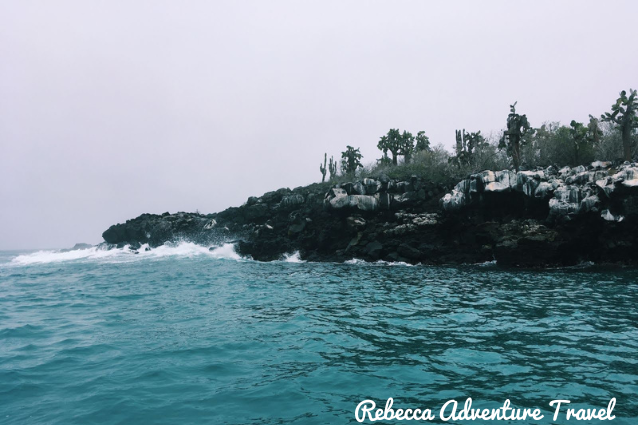
Galapagos Islands is home to a convergence of three currents.
Galapagos weather is so perfect thanks to the convergence of the three currents. Humboldt meets Cromwell, and they both hit the archipelago with cold water. Humboldt’s cold water temperature of 15°C keeps the island in a cool climate. In Galapagos, the water temperature is considered subtropical.
Humboldt Current
The Humboldt Current is a cold water ocean current that flows from Antarctica to the west coast of South America. It’s very important for life in the Galapagos Islands because it brings nutrient-rich water.
This current helps to sustain the archipelago’s rich biodiversity. Moreover, the weather depends on the ocean currents. For instance, cold water is very beneficial for the islands. Thanks to it, penguins can live in the Galapagos. It was named after Alexander Von Humboldt. The naturalist visited Ecuador in 1802. During his stay, Humboldt climbed many volcanoes and mountains in the country, such as Cayambe and Chimborazo. Chimborazo is the highest summit in the country and the closest point to the sun on Earth. Humboldt was fascinated by Ecuador’s landscape. Surrounded by mountains, he named the Andes the “Avenue of the Volcanoes.”
Cromwell Current
The Cromwell Current is a deep flow that originates in the Western Pacific. It flows east, being able to reach the Galapagos. Its cold temperature is nutrient-rich and promotes bio-productivity in the islands. In the equatorial line, the Cromwell Current meets the Peru Oceanic Current, the Peru Coastal Countercurrent, and the Humboldt Current.
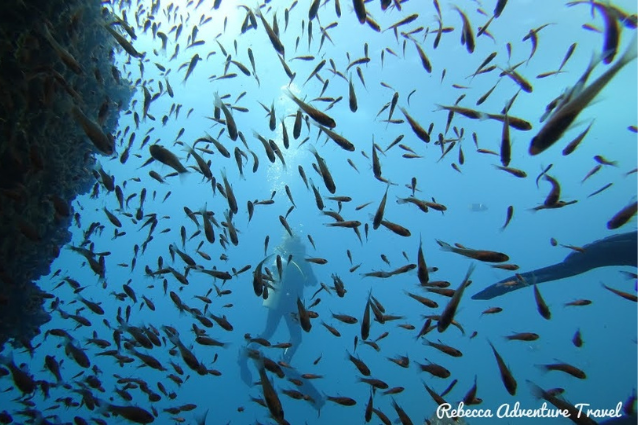
Currents bring cold temperatures with nutrient-rich waters.
Panama Current
The Panama Current flows down to the Galapagos Islands from Central America. It’s a warmer current, also known as El Niño Flow. During the hot season (December to May), the Panama Current makes the water warmer, making it a great time to do underwater activities.
5. A Galapagos Islands fact is that there are species found nowhere else on the Earth
One of the best facts about the Galapagos Islands is that a large majority of the animals that live there can only be found on the islands. Of the total amount of flora and fauna, 42% of the plants, 97% of reptiles and land mammals, 80% of birds, and 56% of insects are endemic. Animals that can only be found in the Galapagos have unique features, showing how they have adapted to the isolated environment.
Galapagos has:
- 600 endemic species of plants.
- 400 species of fish surround the Galapagos with more than 50 endemic species.
- 800 types of mollusks, including oysters, cuttlefish, snails, squids, and octopuses.
What endemic species live in the Galapagos Islands?
The nutrient-rich cold waters are perfect for the development of marine life. As a matter of fact, in the Galapagos 20% of marine life is endemic. For example, the Marine Iguana and the Galapagos Penguin can only be found in the archipelago. The same happens with pelagic species such as tunas, spotted eagle rays, golden rays, and hammerhead sharks.
Apart from the marine species, the submarine landscape is amazing in the Galapagos. You can find mountains, plateaus, ridges, and valleys that surround the islands.
Invertebrates
Terrestrial invertebrates represent 51% of the total biodiversity of the Galapagos. They adapted to the harsh environment of the islands and became endemic. The total number of invertebrates is still unknown. The list includes mollusks, sponges, and corals, among others.
Birds
You can find 56 native bird species in the Galapagos. Of that total, 45 (80%) are endemic, and 11 are indigenous, which means they are native to the islands but can also be found in other parts of the world. There are also 30 migrant species. Only 64 have been spotted once or twice.
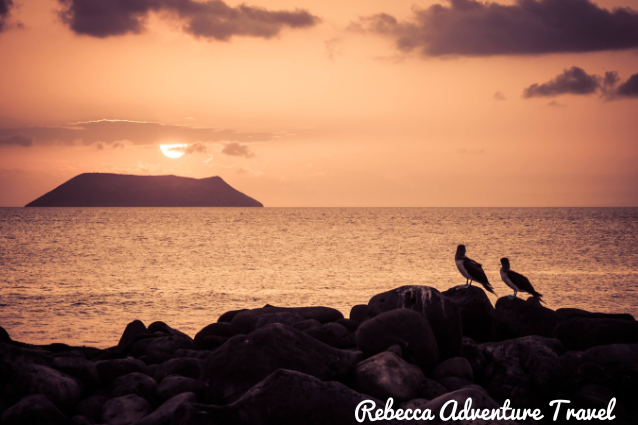
There are 56 native bird species in the Galapagos Islands.
Land birds
Galapagos has 29 resident land birds. Of the total, 22 are endemic. 13 of them are known as Darwin’s Finches, and 4 are Mockingbirds. The other 5 remaining include:
- Galapagos Hawk
- Galapagos Dove
- Galapagos Flycatcher
- Galapagos Rail
- Galapagos Martin
There are also owls, warblers, and cuckoos, among many more. As a matter of fact, Galapagos is a paradise for birdwatching. Even so, birds are known to be very curious and docile, making them attractive to visitors. Even so, Darwin described the Galapagos Doves as tame and beautiful animals.
Seabirds
Tropical birds are easily found on the islands. Tours that include wildlife observation make Galapagos so special. Depending on the season, you can see:
- Blue-footed, Red-footed Boobies, and Nazca Boobies
- Flightless Cormorants
- Frigatebirds
- Red-billed Tropicbirds
- Waved Albatross
- Swallow-tailed Gulls
- Lava Gulls
- Galapagos Penguins
From that list, six are endemic species: the Galapagos Penguin, Flightless Cormorant, Waved Albatross, Galapagos Petrel, Lava Gull, and Swallow-tailed Gull.
Mammals
The variety of mammal species is very limited in the Galapagos. They are commonly located on Ecuador’s mainland. There are only six species found on land that is native to the islands. On the contrary, the Marine Reserve has more diversity.
Most mammals got to the Galapagos by accident. For instance, it’s still not clear how the Rice Rat arrived on the islands. Also, it’s thought that a fierce storm might have brought the famous Galapagos Sea Lions from the South American coast. On land, you can also find the endemic Galapagos Bat and the Hoary Bat. By the sea, there are several species of whales and dolphins.
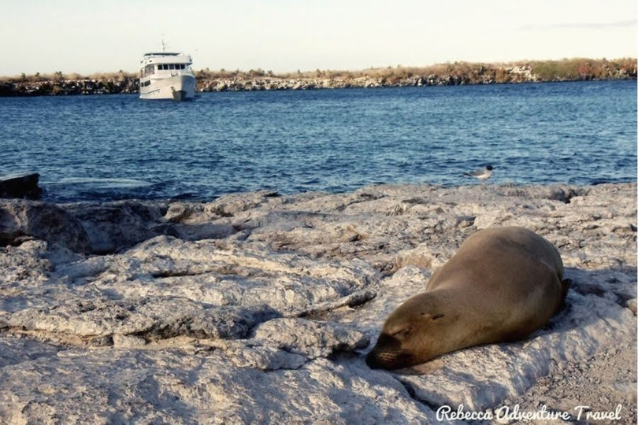
Sea Lions are beautiful mammals that live in the Galapagos Islands.
Nowadays, other mammals live in Galapagos like goats, dogs, pigs, donkeys, and cows. However, they were introduced by humans. These domesticated animals have disastrous consequences for the island’s ecosystems. The Ecuadorian government and ONGs are constantly making aggressive efforts to control their breeding and remove them from the islands.
6. Sea Lions vs Fur Seals
When you start your Galapagos vacation, probably the first animal you’ll encounter is a Sea Lion sleeping on the docks where tourists board cruises. Also, they like to swim around the shorelines. You’ll be able to see them play while you snorkel or dive.
Sea Lions
A fun fact about the Galapagos Islands is that, when they’re on land, Sea Lions congregate in harems. This means that a group of females assemble around a dominant male bull. However, female sea lions can move from harem to harem. It’s a bull’s job to defend the females from other males who want to come close. The job is so exhausting, that bulls only defend a harem for up to three months.
Female Sea Lions give birth to a single pup once a year. They stay with their newborn for five days. After that, she’ll leave him to go fishing. One female is in charge of watching over pups, while the other goes fishing. Sea Lion pups learn to fish when they’re five months old.
Fur Seals
You probably didn’t know that there are Fur Seals in the Galapagos. Interesting facts about the Galapagos Islands include that even though Fur Seals look similar to Sea Lions, they are smaller and have shorter heads. Also, they prefer colder waters and shadier shores. Their name comes from their fur coat.
Fur Seals are nocturnal hunters. They prefer fish and squid. However, they prefer to stay on shore during a full moon, maybe to stay away from sharks!
7. Darwin’s finches can only be found in the Galapagos
There are 13 species of endemic Finches on the Galapagos. Finches are small land birds that diversified and adapted to the island’s different environments. They are known as Darwin’s finches, after Charles Darwin. Darwin analyzed their beaks, which evolved into different food types. If you want to differentiate the finches, check their beak size and shape:
- If the animal has slim, sharp beaks, they are an insect-feeding bird.
- If they have short, thick beaks, they are seed-eating populations.
Darwin’s finches have different shades and tones. Their plumage varies from black, brown, or olive. They have short tails and rounded wings. Even though it’s difficult to identify Finches just by the plumage, the color can help determine the male from the female. For instance, male Finches usually have black plumage, while females have brown plumage.
The simplest way to identify Finches is to check where they live. The medium tree Finch is endemic to Floreana Island, while the large cactus ground Finch can be found in Española, Genovesa, Darwin, and Wolf Islands.
8. Spot three types of boobies
Boobies are seabirds with colorful feet. The possibility to see three types of species is one of the best facts about the Galapagos Islands. Moreover, they can be easily distinguished by their color. The origin of their name comes from the Spanish word bobo, or clumsy. Boobies have a comical way of walking. When they start their mating rituals, the male raises their feet as high as they can, looking silly. They are a favorite of many visitors to the Galapagos!
Blue-footed boobies
Blue-footed Boobies are large birds, with brown plumage, a rump and black tail, and white underpants. Their blue feet make them very easy to recognize. They are very popular thanks to their colorful turquoise feet.
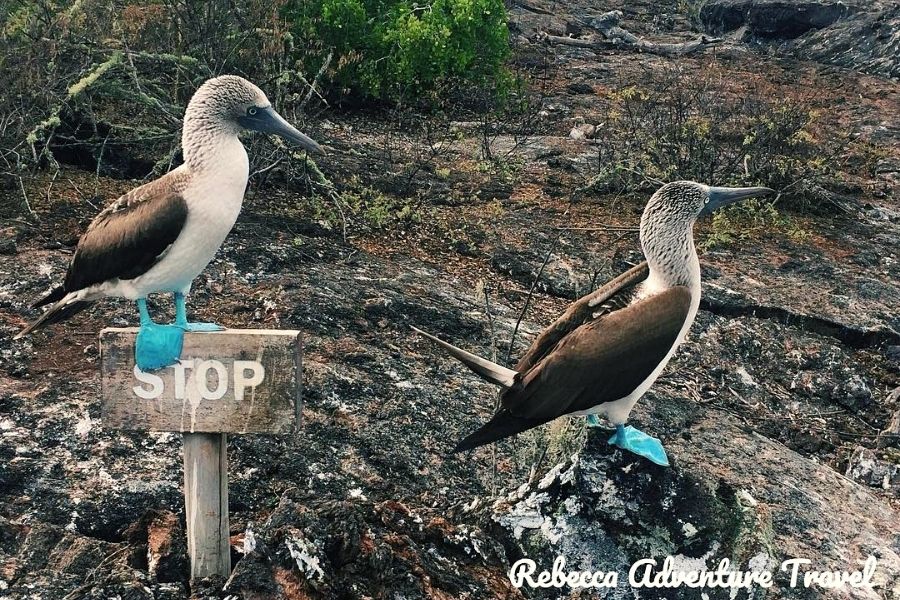
Blue Footed Boobies have colorful turquoise feet.
During the courtship, females prefer brighter feet because they indicate the best quality of genes. Also, females tend to be larger than males, with darker blue feet. The courtship dance is very romantic: males prance about, bow, raise their heads, and spread their wings.
Blue-footed Boobies have an amazing ability in water and air. They can spot small fish from the air, and dive at a speed of 60 mph (96.5 kph).
North Seymour Island is the best seabird breeding ground in the Galapagos. You can see Blue-Footed Boobies there, but also on Española, Fernandina, Floreana, Isabela, Pinzon, and Santa Cruz Islands.
Nazca Boobies
Nazca Boobies are white, and they have black feathers on their tails. They can be easily distinguished from Blue-Footed and Red-Footed Boobies thanks to their foot color and masked face. The male’s beaks are yellow and orange. The females, however, have a more pinkish tone. Also, females are larger in size.
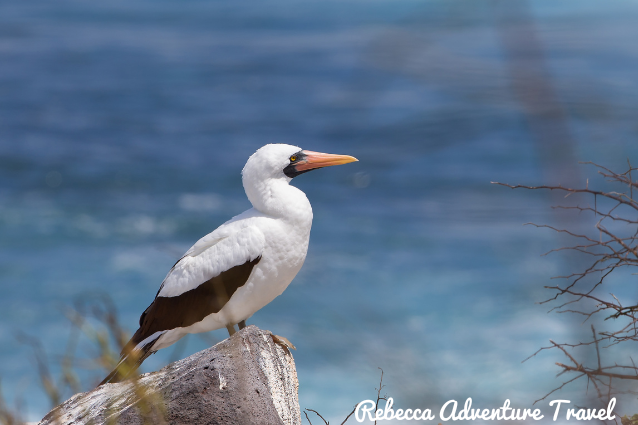
Nazca Boobies have masked faces and black feathers on their tails.
They nest along the ground. They’re the largest of the three. They can be identified thanks to their brilliant white plumage and black-tipped feathers. These types of Boobies can also be found on the Eastern Pacific coastline in South and Central America.
On land, Nazca Boobies can be spotted at Punta Suarez on Espanola Island, Punta Pitt on San Cristobal Island, and on Genovesa Island.
Red-Footed Boobies
Red-footed boobies are the smallest of all Booby species. They have red legs and feet. Adults have pale bluish bills. In Galapagos, these Boobies have a white belly, rump, and tail. Females and males look the same. However, females are usually larger than males. Males can have a longer tail. They use branches of trees and bushes as nesting areas.
These animals can fly over a distance of up to 93 miles (150 km). They are very skillful in the water, having great diving ability. Red-Footed Boobies are able to catch fish while they dive up to 130 ft (40 m) underwater. They can be spotted on Genovesa Island and Punta Pitt on San Cristóbal Island.
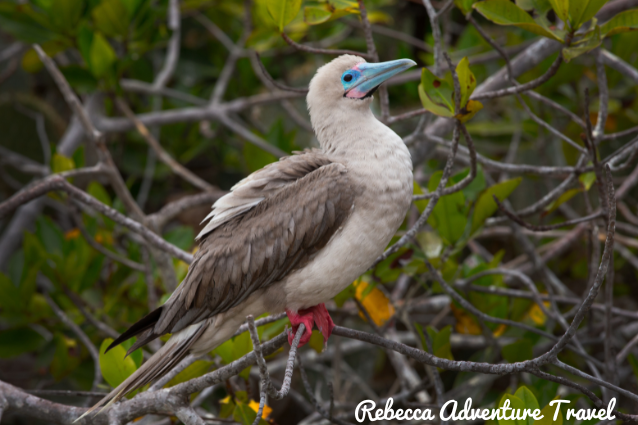
Red-Footed Boobies can be spotted on Genovesa Island and Punta Pitt on San Cristóbal Island.
9. Galapagos has tropical Penguins
The smallest Penguins in the world live in the archipelago! What are some interesting facts about the Galapagos Penguins? The Galapagos Penguins are endemic to the islands. They live at the Equator and swim in tropical waters. However, the water is cool thanks to the intersection of various marine and air currents. A fun fact about Galapagos is that the islands are the only place in the Northern Hemisphere where you can find Penguins in their natural habitat.
Galapagos Penguins are the smaller penguins in the world. 95% of them prefer to live in the cold, nutrient-rich waters of Fernandina and Isabela Islands. They are occasionally seen on Bartolome, Santiago, and Floreana Island, so you’ll need to take a cruise tour to be able to see them. These animals nest at sea level. You can find them in caves, close to shore, and at shallow depths.
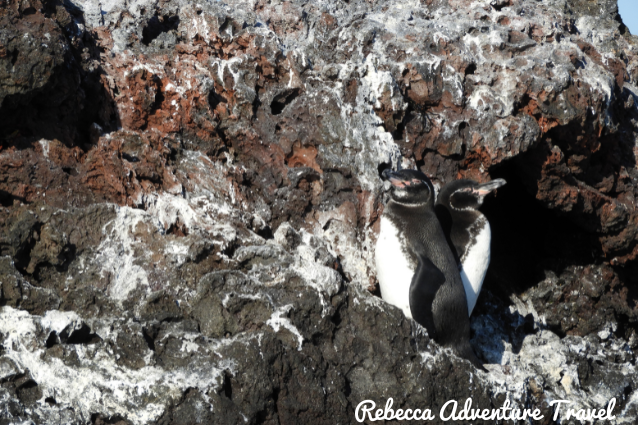
Galapagos Penguins are the smaller penguins in the world.
Penguins take advantage of the abundant food that comes from the rich nutrients of the Humboldt currents that arrive from Antarctica. The best moment to see them is during their nesting season, from May to December.
10. Marine Iguanas are unique animals on Earth
Marine Iguanas are very special animals: they are the only sea-going lizards in the world. They enjoy water so much that they learned how to swim. They use their laterally flattened tails as propellers to go through the water. Even so, their sharp claws help them cling to rocks. These swimming lizards are herbivores, and they prefer to feed on algae and seaweed.
They are endemic to the Galapagos. Adult marine iguanas are black. However, males change during the mating season. Even so, they change colors and adopt different colors: shades of green, turquoise, red, and orange. Also, during mating season, males fight for dominance over females.
11. One of the best facts about the Galapagos Islands is that different species of whales migrate to its waters
Whales and dolphins (cetaceans) are the only aquatic mammals that live on the islands. They are covered with a layer of fat that keeps them warm and provides a reserve of energy. For instance, 24 different species of whales have been identified in the Galapagos. Even though they are not endemic to the islands, because of their migratory activity, it’s very likely to see them swimming peacefully in the Marine Reserve.
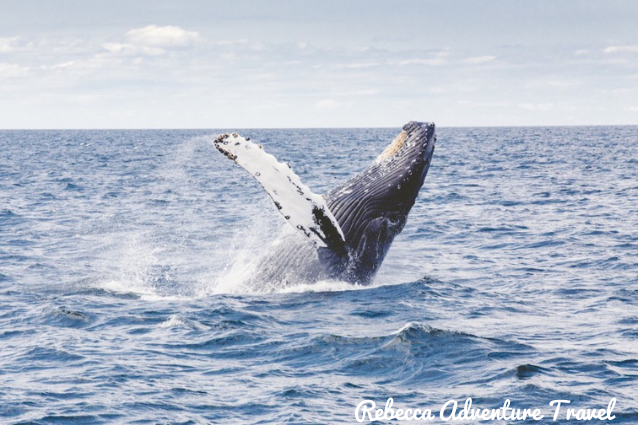
24 different species of whales have been identified in the Galapagos.
When visiting the Galapagos, and depending on the season, lucky tourists can see different types of whales, such as:
- Humpback Whales
- Sperm Whale
- Killer Whale
- False Killer Whale
- Pilot Whale
- Bryde Whale
It’s easier to see whales if you choose a cruise. Cool facts about the Galapagos include an encounter with a whale dance when you least expect it. Maybe the best place for whale watching is the channel between Isabela and Fernandina Islands. Darwin and Wolf Islands are also great spots to see whales, as well as sharks. When you plan your Galapagos vacation, you might want to look for tours from June to November!
12. Giant Tortoises are the oldest vertebrates walking around Earth
Do you know which animals are the oldest existing vertebrates on the planet? Galapagos Tortoises, of course! The average Galapagos Giant Tortoise lives for over a century, making their longevity the highest of any vertebrate on land. Giant Tortoises hold the record for the longest lifespan of any animal on Earth! They eat cactus pads, grasses, and native fruit. It’s amazing that they can survive for one year without eating food or drinking water.
Around the islands, you can see many subspecies of Tortoises. For instance, the ones that live in places where there’s more rain have “dome” shaped shells. On the contrary, the ones that live in drier conditions have a smaller “saddleback” shell.
Interesting Galapagos Islands are that between the 18th and 19th centuries, Giant Tortoises were so abundant on the Galapagos that pirates, whalers, and sailors captured them for their fat. The animals can survive for months without food or water, so travelers kept them on their ships as a means of fresh protein.
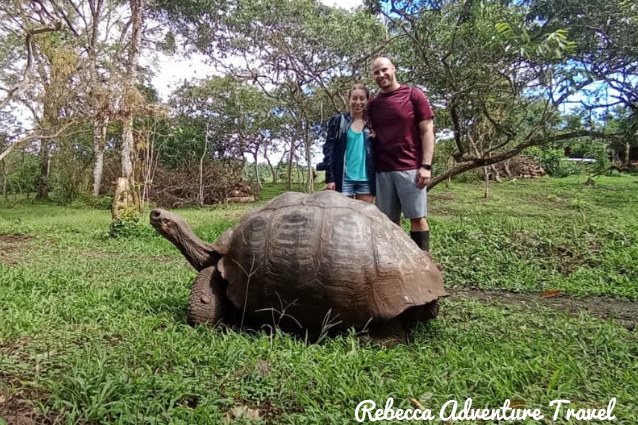
Giant Tortoises are the oldest vertebrates walking around Earth.
The islands were once home to at least 250,000 Tortoises. However, they almost became extinct and nowadays only 15,000 remain in the wild. Even so, on Floreana and Santa Fe Islands Tortoises went extinct in the mid-1800s.
Ecuador protects Galapagos Tortoises
Today, Ecuadorian law protects the Galapagos Tortoises. Also, the Convention on International Trade in Endangered Species of Wild Fauna and Flora (CITES) prohibits all international trade. Even so, in the past years, the Galapagos Conservancy Fund and the Galapagos National Park have restored Giant Tortoise populations.
13. The Lonesome George was about 100 years old when he died
The mysterious and wonderful life of Lonesome George is one of the best facts about the Galapagos Islands. Did you know that George was the last of his species? Until his death in 2012, he was the sole remaining Pinta Island Tortoise (also known as Chelonoidis Abingdon).
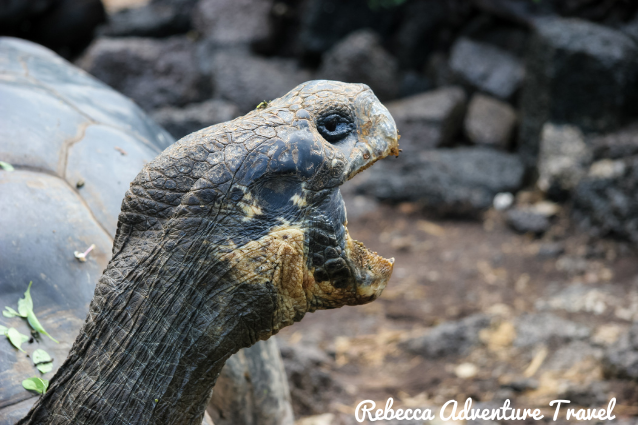
Lonesome George was the sole remaining Pinta Island Tortoise.
Lonesome George was classified as one of the rarest creatures in the world. Over the years, he became a conservation icon.
In 1971, a Hungarian scientist found Lonesome George for the first time. A year later, Galapagos National Park took him into captivity at the Tortoise Center on Santa Cruz Island. Lonesome George didn’t find a breeding partner and had no offspring.
The world mourned Lonesome George’s death
In June 2012, Lonesome George was found dead in his corral at the Tortoise Breeding and Rearing Center on Santa Cruz Island. A Galapagos National Park ranger, Fausto Llerena, found George.
Llerena was part of the expedition that discovered George on Pinta Island. Over the years, he became the giant tortoise’s caretaker. Lonesome George’s age is unknown, but it was estimated at more than 100 years old. He died of natural causes. However, his passing was a shock for scientists due to his young age. Giant Tortoises can live up to 200 years old!
The Ecuadorian government and the Natural Museum of Natural History of New York embalmed George. You can visit Lonesome George and learn with him while touring the same Santa Cruz Island!
14. Green Sea Turtles are peaceful swimmers
Around the world, Green Sea Turtles live in tropical and subtropical waters around the Pacific Ocean. Actually, in the Galapagos, they nest and swim around the islands. The best facts about the Galapagos Islands are that you can easily spot sea turtles on snorkel tours and cruise trips.
Maybe you didn’t know that adult Green Sea Turtles are vegetarians. Juveniles eat almost anything. Also, females lay their eggs at night to avoid predators. They pass the sea’s high tide mark and prepare a nest with their flippers. Normally, they lay between 50 and 200 eggs before they go back to the ocean as the sun rises.
By the way, Green Sea Turtles are not social animals. They prefer to stay alone, as they don’t care for their offspring, don’t form migratory groups, and prefer not to interact with other animals. However, during the nesting season, males and females interact with each other. That’s why, if you want to see pregnant female Green Sea Turtles around the shore, you should book your tour from December to March.
15. Galapagos’ flora and fauna inspired Charles Darwin’s theory of evolution
When Charles Darwin visited the Galapagos Islands, he was instantly mesmerized. Even so, he was so inspired by the animals that he took samples of species. He continued his studies and observations after he left Galapagos.
Which Galapagos Island did Darwin visit?
Charles Darwin embarked on the HMS Beagle ship and spent five years on a scientific expedition. In September 1835, while the ship was on the return route across the Pacific, Darwin arrived at the Galapagos Islands. First, the scientist disembarked on San Cristóbal Island. Then, he visited Floreana, Isabela, and Santiago Islands. Thus, Darwin spent only five weeks on the Galapagos, and he was 26 years old upon his arrival.
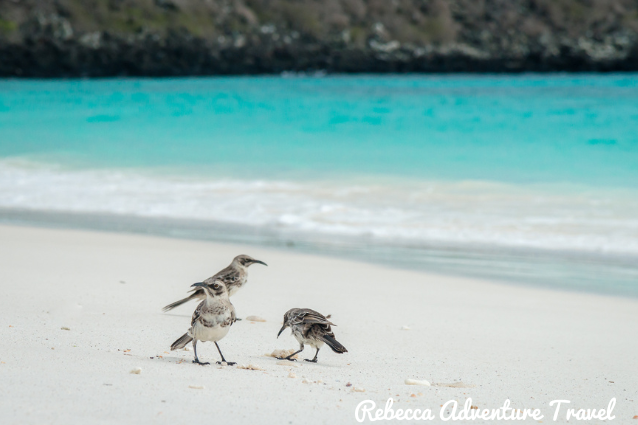
Charles Darwin studies how species changed from island to island.
Captain Robert FitzRoy and his officers worked on their maps and charts. On the other hand, Darwin collected geological and biological specimens. He closely observed species such as the Galapagos Mockingbirds and the Giant Tortoises from different islands. The scientist was a great observer, therefore he located significant variations in birds, plants, and other species.
One of the best facts about the Galapagos Islands is that animals showed Darwin that species change over time
In 1859, 24 years after visiting the Galapagos, Darwin published his findings in On the Origin of Species. Moreover, the book had instant recognition. In his book, the scientist suggested that species change over time by natural selection. Further, he based his theory on the analysis of the plants and animals he gathered during his trips.
According to Charles Darwin, natural selection shows that “species are more likely to survive in their environment and pass on their genes to the next generation when they inherit traits from their parents that are best suited for that specific environment.” His work is a stepping stone in understanding life.
According to Darwin, Galapagos “seems to be a little world within itself.” Thanks to Darwin’s natural selection theory, Galapagos is worldwide famous as a wildlife inspiration. Even so, the Archipelago is a symbol of ecological preservation.
Nowadays, when you book a tour of the Galapagos Islands, you can follow Charles Darwin’s footsteps and see the difference between its incredible endemic species!
16. Who discovered the Galapagos Islands?
Fray Tomás de Berlanga, a Dominican friar, and Bishop of Panama is the official “discoverer” of the Galapagos Islands in March 1535. He described his first encounter with the islands to the King of Spain as a “dross, worthless because it has not the power of raising a little grass, but only some thistles.”
Some interesting facts about the Galapagos Islands are that Berlanga highlighted the number of cacti in inhospitable terrain and the difficulty to find water on the islands. The bishop described how the tide seemed to disappear due to the mist and fog. As a result, he called them “enchanted”.
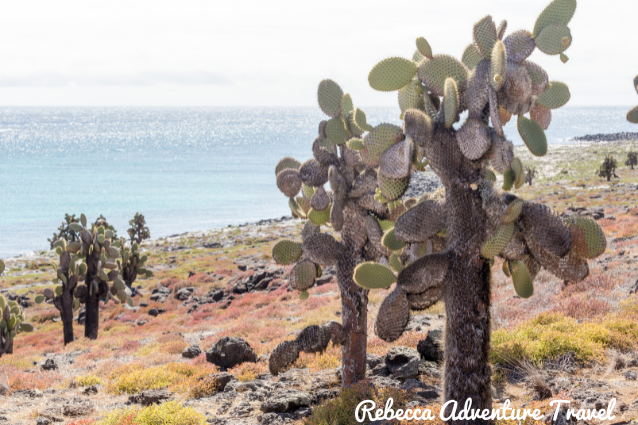
At first sight, Galapagos is an inhospitable terrain, and it’s difficult to find water on the islands.
Cool facts about the Galapagos Islands are that pirates hid their loot in the archipelago
The Galapagos Islands were a hideout for buccaneers, sailors, and whalers. Even Sir Francis Drake used to wander through the islands. Its strategic location was a perfect refuge to stash pirate loot. However, its inhospitable terrain discouraged visitors from permanent settlements.
In the 17th century, Galapagos was part of the Spanish trade routes. On the equator, the islands were strategically located: the distance from the mainland was an advantage for urgent escape, but close enough for commercial journeys. Also, pirates and buccaneers used the islands as a source of food. They preferred giant tortoises’ meat, which helped them survive throughout their never-ending adventures.
Galapagos appeared on a map in the 17th century
William Ambrosia Crowley, a buccaneer that visited the Galapagos Islands during his circumnavigation of the world, published the first chart of the islands in 1684. At the same time, the pirate William Dampier described the Galapagos in his published work A New Voyage Round the World in 1697. He coined some terms we used until now. For instance, he included the word “sea lion” for the first time!
The first inhabitant of the islands was an Irishman
One of the best facts about the Galapagos Islands is that Patrick Watkins, an Irish sailor, was the first settler of the archipelago in 1807. He was abandoned on Floreana Island. He was able to grow vegetables. Further, rumor has it, drank exclusively the rum he traded with boats that stopped at the coast. Two years later, Watkins was able to flee the island by stealing a boat and navigating to Guayaquil, a coastal city in Ecuador.
17. Galapagos is a year-round destination
The amazing thing about the Galapagos Islands is that you can plan your vacation any time of the year! Located along the equator, the archipelago is a year-round destination. Likewise, it has a temperate climate, with two marked seasons:
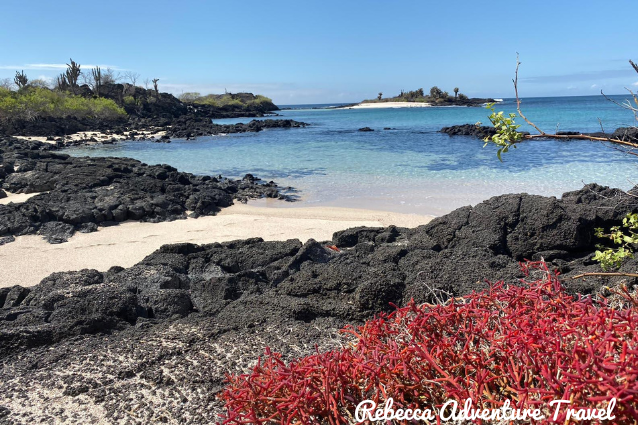
Galapagos Islands is a year-round destination.
Hot season (December through May)
Rain and sun characterize the hot season. During the warm and wet season, tourists will find bright sunlight, lush vegetation, and an intermittent mist or refreshing drizzle.
Overall temperatures:
Land: avg. 72-86°F/30°C.
Water: avg.76°F/25°C.
Dry season (June through November)
During the dry season, tourists can expect cloudy skies, cooler temperatures, and dry weather. The season is neither too hot nor too cold, making it ideal for adventure excursions. Also, tourists will find misty rain. Throughout the dry months, the ocean waters are nutrient-rich thanks to the Humboldt Current. This increases marine activity!
Overall temperatures:
Land: avg. low/high 66-79°F/19-26°C.
Water: avg. 72°F/22°C.
Any time of the year is great to visit the Galapagos
Depending on the season, Galapagos is either lush, green, and tropical, or barren and arid. However, you should know that because of its location, the archipelago isn’t a Caribbean tropical destination. What makes the islands so special and some cool facts about the Galapagos Islands are the volcanic moonscapes, deserted islands, and unique wildlife on land or at sea.
There’s no “best” or “worst” time to plan your Galapagos Islands vacation
When you plan your Galapagos Islands travel and tours, make sure to determine what kind of activities you want to do, and what fauna and flora you want to see. In the islands, there are certain months that fit better your wishes.
For instance, the best time to see land species is during the warmer months (December through May). On the contrary, during the dry season (June through November) there’s an intense marine activity, perfect for snorkeling and scuba diving.
18. Daylight and night skies are a privilege in the Galapagos
Ecuador is a perfect destination because days and nights are of equal duration. Due to its location on the equator line, there are 12 hours of daylight and 12 hours of nighttime, all year. As a result, one of the best facts about the Galapagos Islands is that there’s no need for daylight savings. Therefore, the chances of watching diurnal and nocturnal wildlife increase.
Galapagos timezone is UTC/GMT -6 (one hour earlier than in Ecuador mainland).
Stargazing in the Galapagos
When you look at the sky in the Galapagos you can see a mind-blowing display of the universe. The islands are an astronomy hotspot. Also, its location on the equator allows visitors to see constellations and stars from the Northern and Southern hemispheres.
A fun fact about the Galapagos is that it lies on either side of the equator line! The islands consist of 7880 km² (3040mi²) of land spread over 45,000 km² (17000 mi²) of the ocean.
19. Galapagos has 5 inhabited islands
Are Galapagos Islands inhabited? Yes! Today, more than 25,000 people live in the five inhabited islands: Santa Cruz, San Cristóbal, Isabela, Floreana, and Baltra (Seymour). Only 3% of the islands have human settlements. The other 97% remaining is a national park.

Only 3% of the islands have human settlements. Graph: Charles Darwin Foundation, with data from INEC (2015)
The migration started in the 1960s. Nowadays, the population accounts for less than 0,15% of the total population of Ecuador.
As part of Ecuador, the official language is Spanish. However, you can find tour guides fluent in English, French, German, and other languages.
20. One of the cool facts about the Galapagos Islands is that it had many names before Ecuador established its official identity
The official name of the Galapagos Islands is Archipiélago de Colón. Its name is an honor to the explorer Christopher Columbus (Colón being his Spanish name). Even though he never visited the islands, the Ecuadorian government decided to name the islands after him in 1892, on the 400th anniversary of his voyage to the ‘New World.’
Galapagos had many names before the Ecuadorian government took ownership of the islands in 1832. Thus, sailors called them Enchanted Islands because they seem to “appear and disappear” into the mist.
Moreover, the word “Galapagos” came from galápago, or the Spanish word for a horse saddle, as it looks like Giant Tortoises are wearing saddles. In 1570, the Flemish cartographer Abraham Ortelius included the Galapagos on the world atlas for the first time. He named it “Insulae de los de Galapagos.”
21. Floreana Island has a post office service
Post Office Bay is Floreana Island’s unique postal service. It was a wooden barrel with no stamps, walls, or ceiling. Back in the 18th century, whalers set up a post office where ships frequently passed through. A whiskey barrel eventually became an ingenious communication channel.
Sailors left their letters on the barrel and, at the same time, checked if there were some others they could deliver. Thus, whalers preferred the island because it was a pit stop for fresh water and food. Did you know that Floreana has one of the few freshwater sources in the Archipelago? Also, sailors took tortoises for their meat.
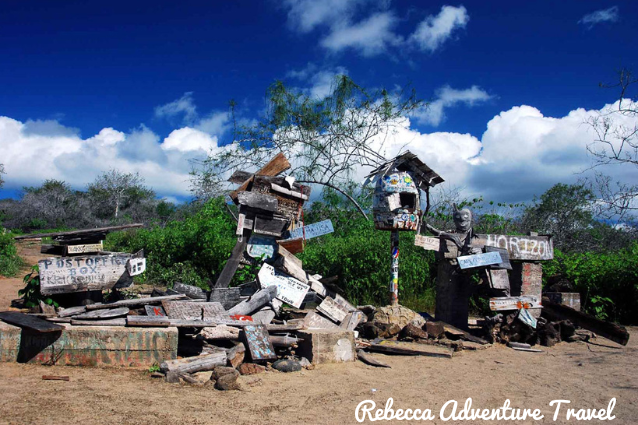
Post Office Bay is Floreana Island’s unique postal service.
Leave a postcard in Floreana’s post office and discover one of the best facts abotut the Galapagos Islands
If you plan a tour to Floreana Island, make sure to leave your own postcard on its Post Office Bay. You don’t need a stamp, just write down an address and hope for the best!
Moreover, you can be part of the sailor’s tradition of delivering correspondence: if you find an address close to your hometown, take it with you and deliver it yourself!
22. Interesting fact about the Galapagos is that the islands had a transcendental role in World War II
Galapagos became a strategic point in the Pacific Ocean. Furthermore, the United States Army Air Force used the islands as a cardinal site to guard the Panama Canal. Even so, in 1911, the US wanted a 99-year lease of the Archipelago for US$ 15 million. Thankfully, former President Eloy Alfaro declined the offer.
Baltra Military Base
Once World War II started, the US government offered Ecuador the option to rent the islands as a military base. The US government started building the Baltra Military Base in 1942. Moreover, Galapagos was part of a geographical triangle of bases, with the others being in Salinas (in mainland Ecuador), and Nicaragua. The Americans used to patrol the ocean for enemy submarines.
In 1943, Galapagos became home to almost 5,000 new men. It grew into the largest colonization of the island, due that up until then the island had 810 people living there. Of course, the arrival of the American soldiers increased the demand for water, food, and services.
23. You can only get to the Galapagos Islands by plane
The only way to access the Galapagos Islands is by plane. However, there are no international flights that go to the Galapagos. Also, there’s no service for boats, cargo ships, or any time of cruise from Ecuador or any other ports. Also, there are no bridges for ground transport.
The archipelago is located 1.396 km (609 miles) away from the continent. So, you need to get to the mainland first. Ecuador has two major international airports:
- José Joaquin de Olmedo International Airport (airport code: GYE), located in Guayaquil.
- Mariscal Sucre International Airport (airport code: UIO), is located in Quito.
Therefore, you can start your trip from Quito or Guayaquil. In both cities there are many things to do, so you can start your vacation by touring around Ecuador first.
Baltra Airport
A cool fact about Galapagos is that Seymour Galapagos Ecological Airport (airport code: GPS), in Baltra Island, works 100% with renewable energy. 35% of the energy comes from photovoltaic systems, and 65% from wind turbines. In order to get to Santa Cruz Island, you can take a water taxi, and then a bus or private transfer.
San Cristóbal Airport
The second airport is San Cristóbal Airport (airport code: SCY), located on San Cristóbal Island. It’s 10 minutes away from the city.
Galapagos inter-island transportation
A great way to experience the Galapagos Islands is by island hopping! You can choose from speed boats or planes.
Speedboats
Speedboats have a capacity of 20 to 40 passengers. On average, the trip is a 2.5-hour journey. There are 2 routes: San Cristóbal – Santa Cruz, and Santa Cruz – Isabela.
Airplanes
For inter-island flights, they’re normally one or two planned flights per day between Baltra, San Cristóbal, and Isabela Islands. Depending on the route, the flight duration is about 30 to 45 minutes. The airplanes have a capacity of 6 to 9 passengers.
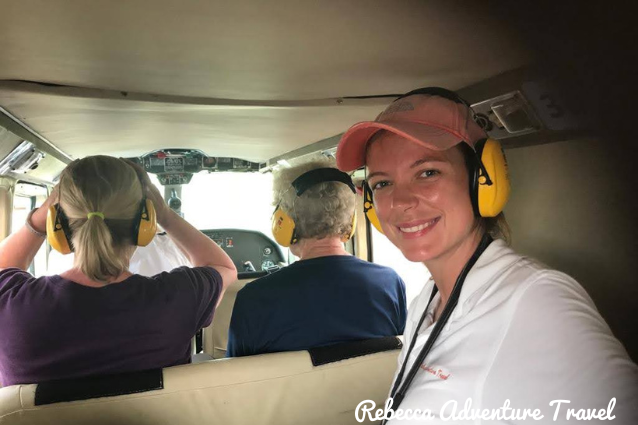
Rebecca enjoying an inter-island flight.
24. One of the best facts about the Galapagos is that scuba diving is a mind-blowing experience!
Galapagos has about 30 diving sites to offer. Therefore, scuba diving is on every diver’s bucket list! When you jump into the ocean, you’re up for an amazing experience. However, seeing wildlife is never 100% sure. It depends on weather conditions, the location, etc. But, in general, you may see marine iguanas, sea turtles, sharks, sea lions, and dolphins, among many others.
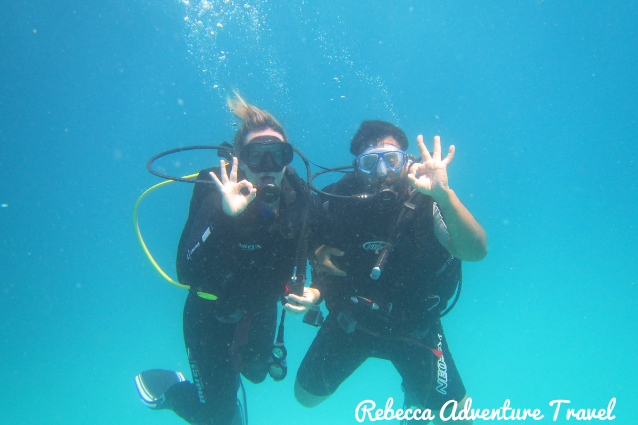
Scuba diving in the Galapagos is mind-blowing.
Remember that 20% of the marine life of the Galapagos is endemic, so you’ll be able to encounter species unique to the islands. Other popular activities include:
- Snorkeling
- Hiking
- Sea kayaking
- Surfing
- horseback riding
- Mountain biking
25. Other fun facts about the Galapagos Islands
Movies
Did you know that the movie Master and Commander was filmed on Bartholomew and Santiago Islands? Famous actors such as Russell Crowe, Paul Bettany, and James D’Arcy visited the islands.
The classic movie The Old Man and the Sea (1958) was also filmed in the Galapagos. Also, there’re many documentaries produced and filmed on the islands:
- The Galapagos Affairs: Satan Came to Eden
- Galápagos
- Galapagos: Hope for the Future
- The Empress of Floreana
Books
If you’re looking for adventure books for your vacation, maybe you should check the one that has the Galapagos as part of its scenario! Some titles are:
- Las Encantadas, or Enchanted Isles (1854): written by American author Herman Melville. It’s based on Melville’s travels on the islands.
- Galapagos (1985) by Kurt Vonnegut: a science fiction novel set one million years in the future.
- Beyond the Islands (1980) by Alicia Yánez Cossío: magic realism novel about eight people who travel to the Galapagos.
There is Much More to Learn
How many of these 25 remarkable Galapagos Islands’ fun facts did you know? If you want to know more about the magical Archipelago and want to book a tour with Rebecca Adventure Travel, one of our Destination Experts will be happy to help! In addition, if you need more information regarding when to travel to Galapagos or Ecuador, you can contact us.
Did you like this post? You might also like:
- Top 5 Family Haciendas around Quito for a Weekend Getaway
- Can you visit the Galapagos Islands on a budget?
- The Best Restaurants in the Galapagos Islands




